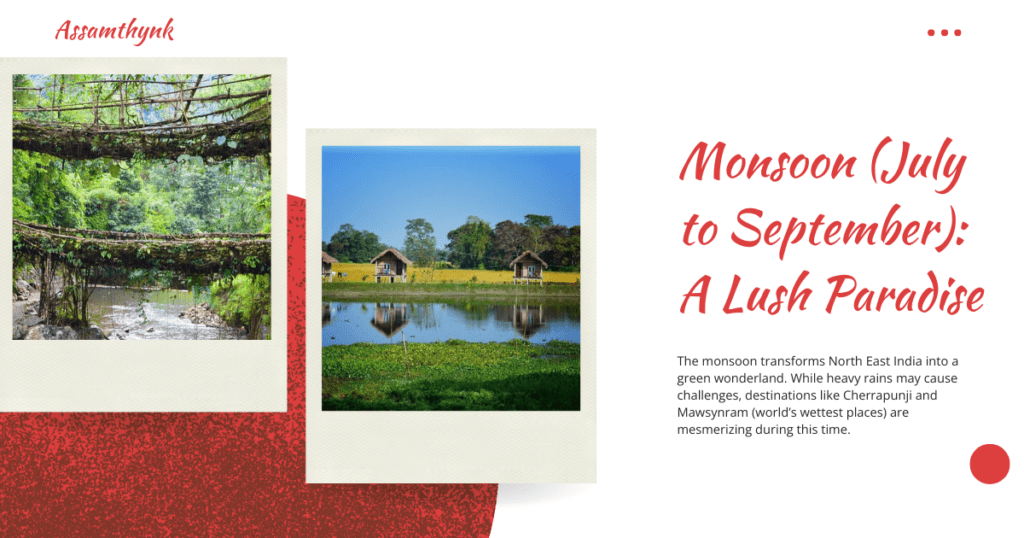Introduction
Phawngpui National Park, also known as the Blue Mountain National Park, is a pristine and lesser-known paradise in the Indian state of Mizoram. Nestled in the southeastern part of the state, the park derives its name from Phawngpui Peak, the highest mountain in Mizoram, standing at an elevation of 2,157 meters (7,077 feet) above sea level. This national park is famous for its diverse flora and fauna, breathtaking landscapes, and cultural significance.
Best Time to Visit Phawngpui National Park
The best time to visit Phawngpui National Park is between October and April when the weather is pleasant, and the landscape is at its most vibrant. During this period, the park’s lush greenery, blooming rhododendrons, and clear skies make it ideal for trekking, wildlife exploration, and photography. The cool and misty winter months (November to February) offer breathtaking views of the valleys and hills, enhancing the park’s natural beauty.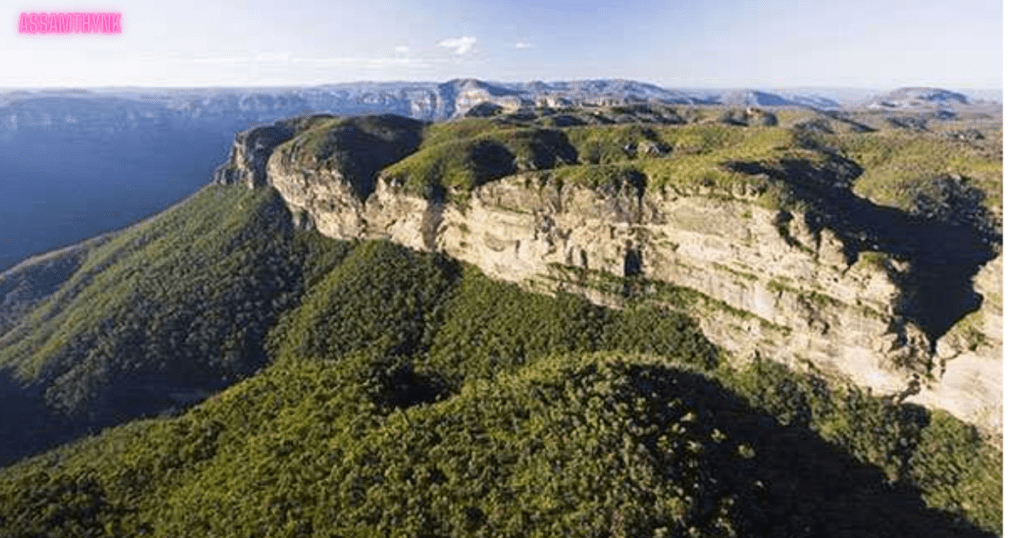
Visiting during the monsoon season (June to September) is not recommended due to heavy rainfall, which makes trekking trails slippery and difficult to navigate. Summers (March to May) remain mild, providing a comfortable environment for birdwatching and nature walks.
For nature enthusiasts, October and November are the best months to witness rhododendrons in full bloom, while February to April offers excellent opportunities for spotting wildlife. Overall, visiting during the dry months ensures a safe and enjoyable experience in this scenic national park.
History and Significance
Phawngpui National Park, established in 1992, is named after Phawngpui Peak, the highest mountain in Mizoram. The park holds deep cultural significance for the Mizo people, who consider Phawngpui a sacred place inhabited by spirits. Legends speak of supernatural beings and a beautiful goddess believed to reside on the blue-hued mountain, adding to its mystical charm.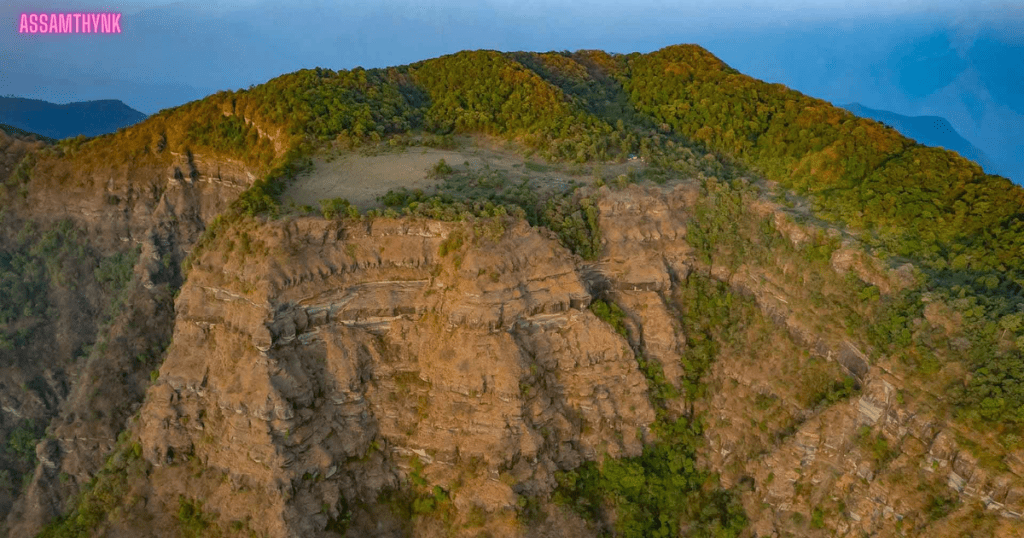
The park was designated a protected area to conserve its rich biodiversity, including rare species like the clouded leopard, Asiatic black bear, and endangered birds such as the Blyth’s tragopan. It plays a crucial role in preserving the fragile ecosystem of Mizoram’s eastern Himalayan region. Phawngpui is also an important site for ecotourism, attracting nature lovers, trekkers, and birdwatchers. The breathtaking landscapes, deep gorges, and colorful rhododendrons enhance its significance as a haven for wildlife and adventure enthusiasts. It remains a vital part of Mizoram’s natural and cultural heritage.
Geography and Climate
Phawngpui National Park is located in Mizoram’s southeastern region, covering the highest peak of the state at 2,157 meters. The park features rolling hills, deep gorges, and lush valleys, offering breathtaking views of the Indo-Myanmar border. It is rich in flora, including rhododendrons, orchids, and dense forests.
The park experiences a moderate subtropical climate. Summers (March–May) are mild, while winters (November–February) are cool and misty. Monsoons (June–September) bring heavy rainfall, making trekking difficult. The best time to visit is between October and April when the weather is pleasant, and the landscape is vibrant with blooming flowers.
Flora
Phawngpui National Park is home to a diverse range of plant species, including tropical and temperate vegetation. The park is dominated by lush evergreen forests, bamboo groves, and rhododendron-covered slopes. Some of the rare plant species found here include orchids, ferns, and medicinal herbs. The park’s floral beauty peaks during the spring and autumn seasons when the rhododendrons bloom in vibrant shades of red, pink, and white.
Fauna
The park serves as a crucial habitat for a variety of wildlife species, making it a haven for nature enthusiasts and wildlife photographers. Some of the notable animal species found in the park include:
- Clouded Leopard – A rare and elusive predator, this big cat is one of the major attractions of the park.
- Asian Black Bear – Often seen foraging in the dense forests, this species is a vital part of the ecosystem.
- Serow – A goat-antelope species that thrives in the rugged mountainous terrain.
- Barking Deer – Commonly found grazing in the meadows and forest clearings.
- Hoolock Gibbon – India’s only ape species, known for its distinctive calls.
Additionally, the park is home to numerous reptiles and amphibians, including various snake species, lizards, and frogs.
Birdlife
Birdwatchers will find Phawngpui National Park to be a paradise, as it houses several rare and exotic bird species. Some of the notable avian species include:
- Blyth’s Tragopan – A colorful and rare pheasant species found in the region.
- Hornbills – Various species of hornbills, including the Great Hornbill and Wreathed Hornbill, can be spotted here.
- Sunbirds and Flycatchers – The park is home to a variety of small, colorful birds that add to its charm.
- Mountain Bamboo Partridge – A species commonly found in the bamboo groves of the park.
Is It Safe to Travel to Phawngpui National Park
Yes, Phawngpui National Park is generally safe for travelers. The park is well-managed by the Mizoram Forest Department, and trekking trails are well-marked. However, visitors should be prepared for remote conditions with limited facilities. It is advisable to hire local guides for trekking and wildlife exploration.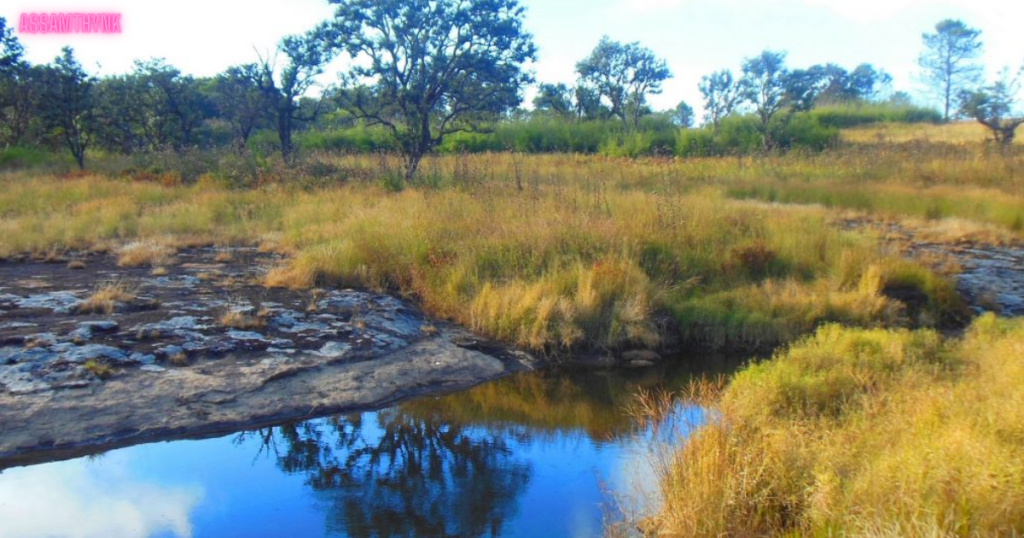
Basic safety measures include carrying essentials like food, water, and a first-aid kit. Travelers should avoid visiting during the monsoon (June–September) due to slippery trails. Following eco-friendly practices and respecting wildlife ensures a safe and enjoyable trip. With proper planning, Phawngpui is a secure and rewarding destination for nature lovers.
Adventure and Activities
Phawngpui National Park offers a range of outdoor activities for adventure seekers and nature lovers. Some of the most popular activities include:
Trekking
Trekking is one of the main attractions in the park, with well-defined trails leading to Phawngpui Peak. The trek offers breathtaking views of the surrounding mountains, deep valleys, and verdant forests. The trek to the peak is moderately challenging and takes around 6-8 hours to complete, depending on the route chosen.
Camping
Camping is an excellent way to experience the park’s tranquility and natural beauty. Visitors can set up tents in designated camping areas and enjoy a night under the stars, surrounded by the sounds of the forest.
Wildlife Photography
With its rich biodiversity, the park provides excellent opportunities for wildlife photography. The dense forests and open meadows offer great chances to capture rare animals and birds in their natural habitat.
Birdwatching
Birdwatchers can explore various trails and vantage points to spot the park’s diverse avian population. Early morning and late afternoon are the best times for birdwatching.
Cultural Importance
The park holds cultural significance for the local Mizo tribes, who believe that Phawngpui Peak is a sacred place. Many traditional festivals and rituals are associated with the mountain. Visitors can also interact with the local communities and learn about their customs, folklore, and way of life.
Conservation Efforts
Phawngpui National Park is a protected area established in 1992 to conserve Mizoram’s rich biodiversity. The park is managed by the Mizoram Forest Department, which implements conservation programs to protect its unique flora and fauna. Efforts include anti-poaching measures, habitat preservation, and afforestation projects. Local communities are involved in eco-tourism initiatives to promote sustainable practices.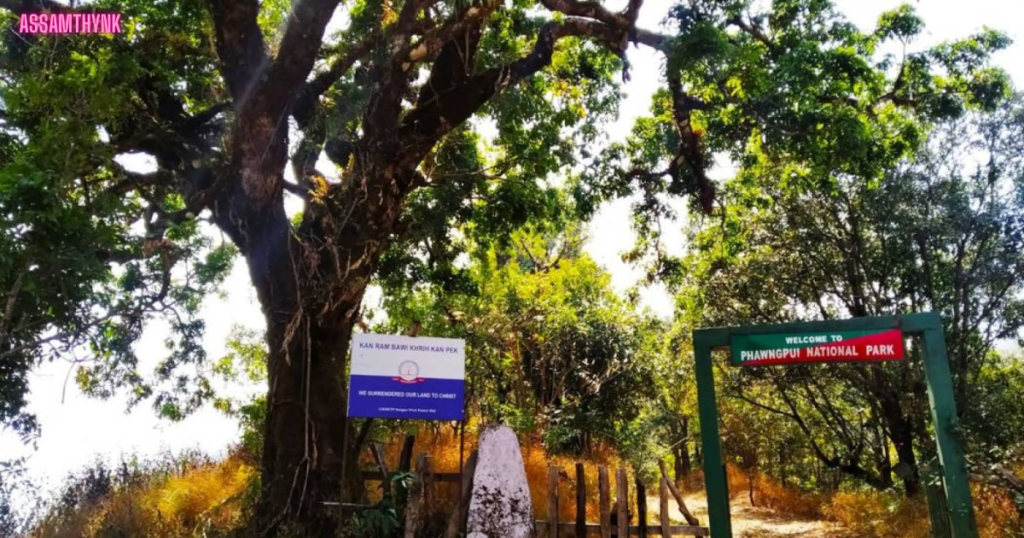
Strict regulations are in place to prevent illegal hunting and deforestation. Awareness campaigns educate visitors and locals about environmental conservation. These efforts help safeguard endangered species like the clouded leopard and Blyth’s tragopan, ensuring the park remains a vital ecological haven.
Attractions Near Phawngpui National Park
Phawngpui National Park, also known as the Blue Mountain National Park, is one of Mizoram’s most beautiful natural reserves. Located in the Lawngtlai district, this park is home to lush green landscapes, rare flora and fauna, and breathtaking views of the surrounding valleys. If you are visiting Phawngpui, here are some nearby attractions worth exploring:
1. Phawngpui Peak
Located within the national park, Phawngpui Peak is the highest mountain in Mizoram, standing at 2,157 meters. It offers mesmerizing views of the surrounding hills and deep gorges. The trek to the peak is a thrilling experience for adventure lovers.
2. Thorangtlang Wildlife Sanctuary
Situated around 80 km from Phawngpui National Park, this sanctuary is home to animals like elephants, barking deer, and leopards. It is a great place for nature lovers and wildlife enthusiasts.
3. Sangau Village
Sangau is the nearest village to Phawngpui and serves as the base for treks into the national park. It offers insights into the traditional lifestyle and culture of the Mizo people.
4. Lunglei Town
About 110 km from the park, Lunglei is the second-largest town in Mizoram. It is known for its scenic beauty, viewpoints, and attractions like Saikuti Hall and Kawmzawl Park.
5. Tiau River
The Tiau River marks the natural border between Mizoram and Myanmar. It is a serene location ideal for relaxation and photography.
Accommodation and Facilities
Phawngpui National Park offers limited accommodation options, primarily in nearby towns like Lawngtlai and Saiha. Basic guesthouses, homestays, and forest rest houses managed by the Mizoram Forest Department provide lodging for visitors. Advanced booking is recommended, especially during peak seasons.
Inside the park, there are no luxury resorts, but camping is a popular option for adventure enthusiasts. Trekking routes are well-marked, and local guides are available for assistance. Basic amenities like food, water, and medical aid are accessible in nearby villages. Visitors are advised to carry essentials and follow eco-friendly practices while exploring the park.
Why Visit Phawngpui National Park?
Phawngpui National Park, also known as Blue Mountain National Park, is a paradise for nature lovers, trekkers, and wildlife enthusiasts. Home to Mizoram’s highest peak (2,157 meters), it offers breathtaking views, lush rhododendron forests, and rich biodiversity. Visitors can spot rare wildlife like the clouded leopard, Asiatic black bear, and Blyth’s tragopan.
The park’s serene environment, deep valleys, and vibrant flora make it ideal for trekking, birdwatching, and photography. Its cultural significance among the Mizo people adds to its charm. A visit to Phawngpui promises adventure, tranquility, and a glimpse of Mizoram’s unspoiled natural beauty.
How to Reach
- By Air: The nearest airport is Lengpui Airport in Aizawl, around 300 km from the park. From Aizawl, visitors can hire taxis or take buses to Saiha and then proceed to the park.
- By Rail: The nearest railway station is in Silchar, Assam, which is around 450 km away. From Silchar, road transport is required to reach the park.
- By Road: The park is well connected by road, with regular buses and taxis available from Aizawl and other nearby towns.
Travel Tips for Visiting Phawngpui National Park
- Best Time to Visit: October to April offers pleasant weather, ideal for trekking and wildlife exploration. Avoid the monsoon season due to heavy rainfall.
- How to Reach: Travel to Aizawl (Lengpui Airport), then take a road journey to Lawngtlai, the nearest town. From there, local transport or trekking is required.
- Pack Essentials: Carry water, food, trekking gear, first-aid, and warm clothing, as facilities are limited.
- Accommodation: Stay in guesthouses or homestays in Lawngtlai or Saiha; camping is also an option.
- Hire a Guide: Local guides enhance the experience and ensure safety on trekking trails.
- Respect Nature: Avoid littering, follow eco-friendly practices, and respect local customs.
- Wildlife Safety: Maintain a safe distance from animals and avoid loud noises.
- Permit Requirements: Foreign tourists need an Inner Line Permit (ILP), available in Aizawl.
Top 10 FAQs About Phawngpui National Park
- What is Phawngpui National Park?
Phawngpui National Park, also known as the Blue Mountain National Park, is a protected area in Mizoram, India, known for its breathtaking landscapes, rich biodiversity, and the highest peak in the state, Phawngpui Peak (2,157 meters). - Where is Phawngpui National Park located?
It is situated in the Lawngtlai district of Mizoram, near the Myanmar border, in the southeastern part of the state. - How can I reach Phawngpui National Park?
The nearest airport is Lengpui Airport (Aizawl), about 300 km away. From Aizawl, one can travel by road to Sangau village, the base for the park. The nearest railway station is in Silchar, Assam. - What is the best time to visit Phawngpui National Park?
The best time to visit is from October to April, when the weather is pleasant and ideal for trekking and wildlife spotting. Monsoons (June–September) can make travel difficult due to heavy rainfall. - What is Phawngpui National Park famous for?
The park is famous for its scenic beauty, diverse flora and fauna, and Phawngpui Peak, which offers stunning panoramic views. It is also home to rare species like the clouded leopard, Hoolock gibbons, and exotic birds such as the Blyth’s tragopan. - What activities can be done in Phawngpui National Park?
Visitors can enjoy trekking, birdwatching, wildlife photography, nature walks, and camping amidst the park’s serene environment. - Is permission required to visit the park?
Yes, tourists need permission from the Mizoram Forest Department. Non-Mizos (including foreigners and other Indian citizens) also require an Inner Line Permit (ILP) to enter Mizoram. - Are there accommodations available near Phawngpui National Park?
Basic accommodations are available in Sangau village, the nearest settlement. Visitors can also stay in Aizawl and make travel arrangements to the park. Camping is an option for adventure seekers. - What kind of wildlife can be seen in the park?
The park is home to wildlife such as leopards, serows, barking deer, slow lorises, gibbons, and many species of birds like hornbills, pheasants, and sunbirds. - Why is Phawngpui National Park called the ‘Blue Mountain’?
The name “Blue Mountain” comes from the bluish haze that often surrounds Phawngpui Peak, giving it a mystical and enchanting appearance.
Conclusion
Phawngpui National Park is a hidden gem in Mizoram, offering breathtaking natural beauty, rich biodiversity, and cultural significance. Whether you are a nature lover, adventure enthusiast, or wildlife photographer, this park has something to offer. Visiting Phawngpui is a unique experience that allows travelers to connect with nature and explore one of India’s most pristine and untouched landscapes.



